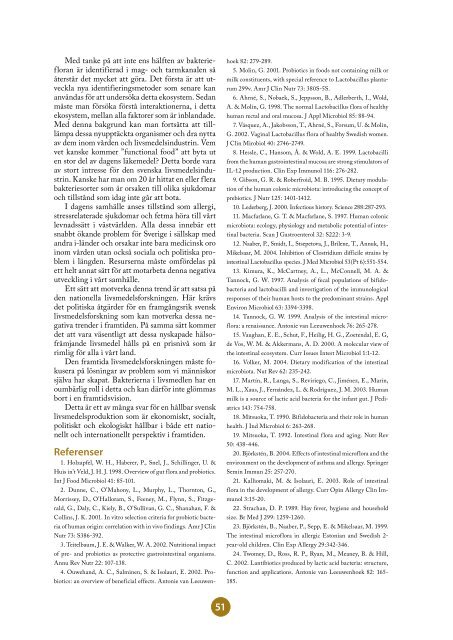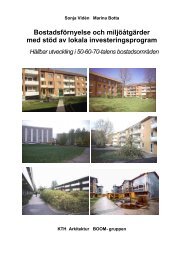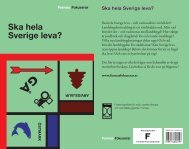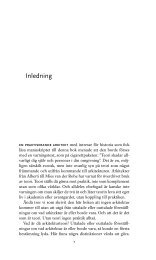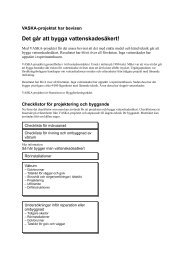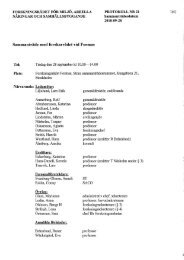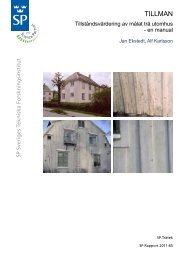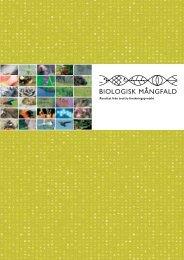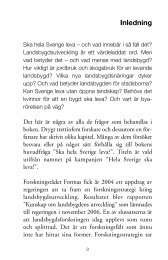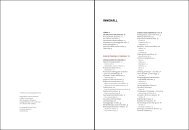Ladda ned - Formas
Ladda ned - Formas
Ladda ned - Formas
You also want an ePaper? Increase the reach of your titles
YUMPU automatically turns print PDFs into web optimized ePapers that Google loves.
Med tanke på att inte ens hälften av bakteriefloran<br />
är identifierad i mag- och tarmkanalen så<br />
återstår det mycket att göra. Det första är att utveckla<br />
nya identifieringsmetoder som senare kan<br />
användas för att undersöka detta ekosystem. Sedan<br />
måste man försöka förstå interaktionerna, i detta<br />
ekosystem, mellan alla faktorer som är inblandade.<br />
Med denna bakgrund kan man fortsätta att tilllämpa<br />
dessa nyupptäckta organismer och dra nytta<br />
av dem inom vården och livsmedelsindustrin. Vem<br />
vet kanske kommer ”functional food” att byta ut<br />
en stor del av dagens läkemedel? Detta borde vara<br />
av stort intresse för den svenska livsmedelsindustrin.<br />
Kanske har man om 20 år hittat en eller flera<br />
bakteriesorter som är orsaken till olika sjukdomar<br />
och tillstånd som idag inte går att bota.<br />
I dagens samhälle anses tillstånd som allergi,<br />
stressrelaterade sjukdomar och fetma höra till vårt<br />
levnadssätt i västvärlden. Alla dessa innebär ett<br />
snabbt ökande problem för Sverige i sällskap med<br />
andra i-länder och orsakar inte bara medicinsk oro<br />
inom vården utan också sociala och politiska problem<br />
i längden. Resurserna måste omfördelas på<br />
ett helt annat sätt för att motarbeta denna negativa<br />
utveckling i vårt samhälle.<br />
Ett sätt att motverka denna trend är att satsa på<br />
den nationella livsmedelsforskningen. Här krävs<br />
det politiska åtgärder för en framgångsrik svensk<br />
livsmedelsforskning som kan motverka dessa negativa<br />
trender i framtiden. På samma sätt kommer<br />
det att vara väsentligt att dessa nyskapade hälsofrämjande<br />
livsmedel hålls på en prisnivå som är<br />
rimlig för alla i vårt land.<br />
Den framtida livsmedelsforskningen måste fokusera<br />
på lösningar av problem som vi människor<br />
själva har skapat. Bakterierna i livsmedlen har en<br />
oumbärlig roll i detta och kan därför inte glömmas<br />
bort i en framtidsvision.<br />
Detta är ett av många svar för en hållbar svensk<br />
livsmedelsproduktion som är ekonomiskt, socialt,<br />
politiskt och ekologiskt hållbar i både ett nationellt<br />
och internationellt perspektiv i framtiden.<br />
Referenser<br />
1. Holzapfel, W. H., Haberer, P., Snel, J., Schillinger, U. &<br />
Huis in’t Veld, J. H. J. 1998. Overview of gut flora and probiotics.<br />
Int J Food Microbiol 41: 85-101.<br />
2. Dunne, C., O’Mahony, L., Murphy, L., Thornton, G.,<br />
Morrissey, D., O’Halloram, S., Feeney, M., Flynn, S., Fitzgerald,<br />
G., Daly, C., Kiely, B., O’Sullivan, G. C., Shanahan, F. &<br />
Collins, J. K. 2001. In vitro selection criteria for probiotic bacteria<br />
of human origin: correlation with in vivo findings. Amr J Clin<br />
Nutr 73: S386-392.<br />
3. Teitelbaum, J. E. & Walker, W. A. 2002. Nutritional impact<br />
of pre- and probiotics as protective gastrointestinal organisms.<br />
Annu Rev Nutr 22: 107-138.<br />
4. Ouwehand, A. C., Salminen, S. & Isolauri, E. 2002. Probiotics:<br />
an overview of beneficial effects. Antonie van Leeuwen-<br />
51<br />
hoek 82: 279-289.<br />
5. Molin, G. 2001. Probiotics in foods not containing milk or<br />
milk constituents, with special reference to Lactobacillus plantarum<br />
299v. Amr J Clin Nutr 73: 380S-5S.<br />
6. Ahrné, S., Nobaek, S., Jeppsson, B., Adlerberth, I., Wold,<br />
A. & Molin, G. 1998. The normal Lactobacillus flora of healthy<br />
human rectal and oral mucosa. J Appl Microbiol 85: 88-94.<br />
7. Vásquez, A., Jakobsson, T., Ahrné, S., Forsum, U. & Molin,<br />
G. 2002. Vaginal Lactobacillus flora of healthy Swedish women.<br />
J Clin Mirobiol 40: 2746-2749.<br />
8. Hessle, C., Hansom, Å. & Wold, A. E. 1999. Lactobacilli<br />
from the human gastrointestinal mucosa are strong stimulators of<br />
IL-12 production. Clin Exp Immunol 116: 276-282.<br />
9. Gibson, G. R. & Roberfroid, M. B. 1995. Dietary modulation<br />
of the human colonic microbiota: introducing the concept of<br />
prebiotics. J Nutr 125: 1401-1412.<br />
10. Lederberg, J. 2000. Infectious history. Science 288:287-293.<br />
11. Macfarlane, G. T. & Macfarlane, S. 1997. Human colonic<br />
microbiota: ecology, physiology and metabolic potential of intestinal<br />
bacteria. Scan J Gastroenterol 32: S222: 3-9.<br />
12. Naaber, P., Smidt, I., Stsepetova, J., Brilene, T., Annuk, H.,<br />
Mikelsaar, M. 2004. Inhibition of Clostridium difficile strains by<br />
intestinal Lactobacillus species. J Med Microbiol 53(Pt 6):551-554.<br />
13. Kimura, K., McCartney, A., L., McConnell, M. A. &<br />
Tannock, G. W. 1997. Analysis of fecal populations of bifidobacteria<br />
and lactobacilli and investigation of the immunological<br />
responses of their human hosts to the predominant strains. Appl<br />
Environ Microbiol 63: 3394-3398.<br />
14. Tannock, G. W. 1999. Analysis of the intestinal microflora:<br />
a renaissance. Antonie van Leeuwenhoek 76: 265-278.<br />
15. Vaughan, E. E., Schut, F., Heilig, H. G., Zoetendal, E. G,<br />
de Vos, W. M. & Akkermans, A. D. 2000. A molecular view of<br />
the intestinal ecosystem. Curr Issues Intest Microbiol 1:1-12.<br />
16. Volker, M. 2004. Dietary modification of the intestinal<br />
microbiota. Nut Rev 62: 235-242.<br />
17. Martín, R., Langa, S., Reviriego, C., Jiménez, E., Marín,<br />
M. L., Xaus, J., Fernández, L. & Rodríguez, J. M. 2003. Human<br />
milk is a source of lactic acid bacteria for the infant gut. J Pediatrics<br />
143: 754-758.<br />
18. Mitsuoka, T. 1990. Bifidobacteria and their role in human<br />
health. J Ind Microbiol 6: 263-268.<br />
19. Mitsuoka, T. 1992. Intestinal flora and aging. Nutr Rev<br />
50: 438-446.<br />
20. Björkstén, B. 2004. Effects of intestinal microflora and the<br />
environment on the development of asthma and allergy. Springer<br />
Semin Immun 25: 257-270.<br />
21. Kalliomaki, M. & Isolauri, E. 2003. Role of intestinal<br />
flora in the development of allergy. Curr Opin Allergy Clin Immunol<br />
3:15-20.<br />
22. Strachan, D. P. 1989. Hay fever, hygiene and household<br />
size. Br Med J 299: 1259-1260.<br />
23. Björkstén, B., Naaber, P., Sepp, E. & Mikelsaar, M. 1999.<br />
The intestinal microflora in allergic Estonian and Swedish 2year-old<br />
children. Clin Exp Allergy 29:342-346.<br />
24. Twomey, D., Ross, R. P., Ryan, M., Meaney, B. & Hill,<br />
C. 2002. Lantibiotics produced by lactic acid bacteria: structure,<br />
function and applications. Antonie van Leeuwenhoek 82: 165-<br />
185.


